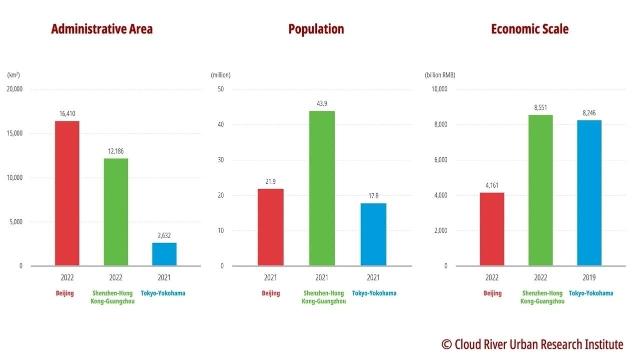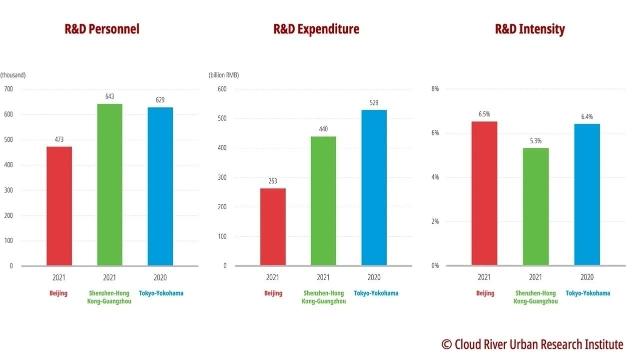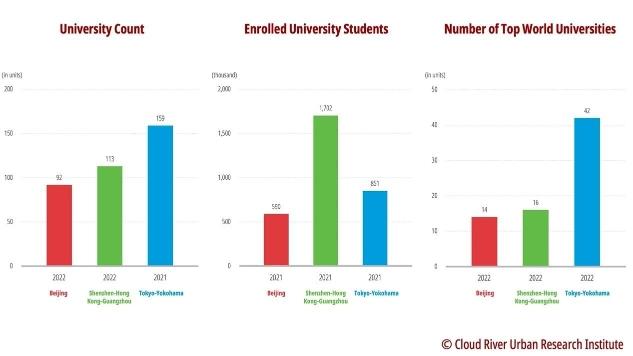China.org.cn | August 29, 2023
Editor's note:
In September 2022, the World Intellectual Property Organization (WIPO) released the Global Innovation Index report, ranking Tokyo-Yokohama, Shenzhen-Hong Kong-Guangzhou, and Beijing as the top three global science and technology innovation clusters. In response to this, the Counsellor's Office of the Beijing Municipal People's Government and the Cloud River Urban Research Institute collaborated to conduct a comparative study titled "Research on the Science and Technology Innovation Performance of the Top Three Global Science and Technology Clusters." This article, serving as an abstract of the report, focuses on exploring Beijing's distinct characteristics in terms of patent applications, research paper publications, R&D intensity, the quantity and quality of universities, among other aspects. Addressing Beijing's strong academic research capabilities and comparatively weaker practical abilities, the article also presents recommendations for leveraging practical applications to drive the cluster development of technological and innovative enterprises.
The Global Innovation Index (GII) has been assessing global science and technology clusters since 2017, quantifying the spatial concentration of technological innovation activities. Looking back at the reports from previous years, it's clear that the Tokyo-Yokohama and Shenzhen-Hong Kong-Guangzhou clusters have consistently held the first and second positions, respectively, in the global science and technology cluster rankings. In contrast, Beijing has moved up from 7th place in 2017 to 3rd place in 2021, maintaining this position in 2022.
To address the fact that the GII relies solely on two indicators- WIPO's Patent Cooperation Treaty (PCT) patent applications and scientific publication counts - for ranking global science and technology clusters, this report takes a broader approach by incorporating indicators from the "China Integrated City Index" by the Cloud River Urban Research Institute. This comprehensive analysis allows for a more holistic comparison of the top three science and technology clusters and delves into the distinctive features, strengths, and areas of improvement of Beijing's technological innovation landscape.
1. The top three science and technology clusters demonstrate distinct advantages in patent applications and scientific publications
The ranking of science and technology clusters in the GII report is based on the identification of clusters through the locations of inventors listed in international patent applications and authors of scientific journal articles. In the initial GII report of 2017, the evaluation of global science and technology clusters relied solely on the indicator of patent applications under the PCT. Starting from 2018, the report incorporated the indicator of scientific publication counts from Science Citation Index-Expanded provided by Clarivate, and this approach has been continuing today.
When comparing the performance of the top three science and technology clusters in these two indicators, it becomes evident that each cluster showcases distinct advantages with different focuses.
① Tokyo-Yokohama: More active in patent applications than scientific paper publications
Tokyo-Yokohama demonstrates a significant advantage in PCT patent applications. In 2018, the cluster filed 104,746 patent applications, accounting for 11% of the global total, which was nearly 6 percentage points higher than the second-ranking Shenzhen-Hong Kong-Guangzhou cluster. Although the number of patent applications increased to 122,526 in 2022, maintaining its world-first position, its lead over the second-ranking Shenzhen-Hong Kong-Guangzhou cluster has significantly reduced to 2.5 percentage points.
However, Tokyo-Yokohama's advantage in scientific paper publications has noticeably declined over the years. In 2018, the cluster published 141,584 scientific papers, accounting for 1.8% of the global total and ranking second worldwide. However, by 2022, the number of scientific paper publications had dropped by 20% compared to 2018, with a global share of 1.6% and a decline in the global ranking to fifth place.
This indicates that Tokyo-Yokohama is more active in patent applications than in scientific paper publications. The interaction between research and industry stands as a pivotal factor supporting this cluster's position as the world's premier science and technology cluster.
② Shenzhen-Hong Kong-Guangzhou: Rapid growth in both patent applications and scientific paper publications
The Shenzhen-Hong Kong-Guangzhou cluster has witnessed rapid growth in both patent applications and scientific paper publications. In 2018, the cluster filed 48,084 PCT patent applications, accounting for 5.1% of the global total and ranking second globally. By 2022, the number of PCT patent applications doubled compared to 2018, with a global share of 8.2%, significantly narrowing the gap with the world's top science and technology cluster, Tokyo-Yokohama.
In terms of scientific paper publications, the cluster only published 40,920 papers globally, accounting for 0.5% of the global total and ranking 32nd in the world in 2018. However, by 2022, the number of scientific paper publications had surged to more than three times that of 2018, with a global share of 1.9%. This accomplishment surpassed Tokyo-Yokohama, propelling the cluster to third position in global ranking.
The Shenzhen-Hong Kong-Guangzhou cluster's rapid development momentum poses an increasingly significant threat to Tokyo-Yokohama's position as the leading global science and technology cluster.
③ Beijing: Prominent advantage in scientific paper publications
Beijing stands out with a significant advantage in scientific paper publications. In 2018, the city produced 197,175 scientific papers, representing 2.5% of the worldwide output. This figure is 1.4 times higher than that of Tokyo-Yokohama, securing the top global position. By 2022, Beijing's scientific paper publications had grown by 24% compared to 2018, accounting for 3.7% of the global share, and maintaining its strong global leadership.
However, Beijing's performance in patent applications is relatively lower. In 2018, the city submitted 18,041 PCT patent applications, making up 1.9% of the global total and ranking eighth worldwide. By 2022, its global patent application share had increased to 2.8%, elevating its global ranking to sixth.
The robust foundation of numerous prestigious institutions led by the Chinese Academy of Sciences, Tsinghua University, and Peking University contributes to Beijing's impressive scientific paper output. The consistent growth in scientific paper publications in recent years has significantly enhanced Beijing's global position within the science and technology cluster.
2.Beijing enjoys the largest administrative area, second-largest population, and smallest economic scale among the three clusters
Among the three major science and technology clusters, Beijing has the largest administrative area, spanning 16,410 square kilometers. This is 1.3 times the size of Shenzhen-Hong Kong-Guangzhou and 6.2 times that of Tokyo-Yokohama.
In terms of population, Shenzhen-Hong Kong-Guangzhou has the largest population, reaching 43.9 million, which is double the population of Beijing and 2.5 times that of Tokyo-Yokohama.
When it comes to economic scale, Shenzhen-Hong Kong-Guangzhou takes the lead with a GDP slightly surpassing that of Tokyo-Yokohama, amounting to 8.55 trillion yuan. In comparison, Beijing's economic scale is only about half of the former.
Among these three major science and technology clusters, Tokyo-Yokohama boasts the highest per capita GDP at 463,000 yuan, which is 2.4 times that of both Beijing and Shenzhen-Hong Kong-Guangzhou.
Figure 1. A comparison of three major science and technology clusters in terms of administrative area, population and economic scale

3. Beijing demonstrates highest R&D Intensity, yet lags behind in R&D expenditure and personnel
① R&D expenditure: Tokyo-Yokohama takes the lead
Among the three major science and technology clusters, Tokyo-Yokohama boasts the highest R&D expenditure, reaching 529.5 billion yuan. This surpasses Shenzhen-Hong Kong-Guangzhou by 1.2 times and Beijing by double.
Beijing records the lowest total R&D expenditure within this group.
② R&D intensity: Beijing holds the top spot
Due to economic variations, the "R&D expenditure/GDP" ratio, known as "R&D intensity," is often used to gauge the commitment to research and development.
Among the three clusters, despite having the lowest total R&D expenditure, Beijing claims the highest R&D intensity at 6.5%. This marginally surpasses Tokyo-Yokohama and leads Shenzhen-Hong Kong-Guangzhou by 1.2 percentage points.
③ R&D personnel: Beijing has the fewest
Regarding R&D personnel, there's a marginal difference between Shenzhen-Hong Kong-Guangzhou and Tokyo-Yokohama, with 643,000 and 629,000 research personnel, respectively.
Beijing employs the fewest R&D personnel, at 473,000, which constitutes about three-quarters of the workforce in the other two science and technology clusters.
④ Per capita research funding for researchers: Beijing still lags behind
When considering per capita research funding for researchers, Tokyo-Yokohama leads with 842,000 yuan, followed by Shenzhen-Hong Kong-Guangzhou with 684,000 yuan, and then Beijing with 556,000 yuan.
Beijing exhibits a marked difference compared to Tokyo-Yokohama, with its figure only amounting to 66% of the latter's.
Figure 2. A comparison of three major clusters in terms of R&D figures

4.Beijing boasts Asia's top-ranked universities, but lags in the number of universities and student enrollment
Universities serve as both the cradle for nurturing innovative talents and essential bases for research and development. This report also compares the higher education resources among the three major science and technology clusters.
① University count: Tokyo-Yokohama takes the lead
Among the three clusters, Tokyo-Yokohama has the highest number of universities, totaling 159. This is 1.4 times that of Shenzhen-Hong Kong-Guangzhou and 1.7 times that of Beijing. Shenzhen-Hong Kong-Guangzhou and Beijing have 113 and 92 universities, respectively.
② Enrolled university students: Shenzhen-Hong Kong-Guangzhou takes the lead
In terms of enrolled university students, Shenzhen-Hong Kong-Guangzhou boasts the highest number among the three clusters, reaching 1.702 million. Tokyo-Yokohama ranks second with 851,000 students, while Beijing has the fewest at only 590,000, equivalent to one-third of the number in Shenzhen-Hong Kong-Guangzhou.
③ Beijing houses Asia's top-ranked universities, but lags in the number of universities making the top 500 World University Rankings
Among the three clusters, Beijing is home to Asia's highest-ranked universities, yet it falls short in terms of the number of universities featured in the global university rankings.
According to the 2022 Times Higher Education World University Rankings, Tokyo-Yokohama has an impressive 42 universities featured in the top 500 list. In comparison, Shenzhen-Hong Kong-Guangzhou has 16 universities on the list. While Beijing is home to Asia's top-ranked Tsinghua University and Peking University, it has only 14 universities listed, marking the lowest count among the three major science and technology clusters.
Figure 3. A comparison of science and technology clusters in terms of university figures

5. Beijing: Strong academic research capacity but relatively weak industrial applications
Based on the analysis above, within the three major science and technology clusters, Beijing possesses the fewest resources in terms of R&D personnel, research funding, per capita research funding for researchers, and the number of universities. Nevertheless, it boasts the highest R&D intensity. Beijing's consistent top position in R&D intensity among the 297 cities of prefecture-level or above in China underscores its substantial commitment to innovation.
Beijing's another advantage is its abundance of prestigious universities and top-tier research institutions, hosting approximately one-third of the nation's key national laboratories and nearly half of its academicians.
While Beijing's dedication to innovation and its abundant scientific research resources place it at the forefront of scientific publication, it's also making noteworthy progress in PCT patent applications. However, in comparison to the other two major science and technology clusters, Beijing demonstrates relatively weaker interplay between research and industrial application.
6. Application strategy: Driving cluster development of innovative enterprises through widespread technological implementation
Considering the strengths and weaknesses identified in Beijing's case above, this report recommends that Beijing embark on expansive application initiatives across sectors such as new energy utilization, urban rail transit systems, including tramways, energy-efficient architecture, and digitization. By enhancing the city's infrastructure and technological prowess through upgrades, Beijing can effectively drive the synergistic growth of innovative enterprises within these realms.
For Beijing, a city with a substantial market, this strategy of generating real-world demand holds immense importance. It not only fosters the conversion of research accomplishments into products and services but also propels the cluster-based development of enterprises.
Taking high-speed railway as an example, Japan pioneered the world's inaugural high-speed rail system in 1964. The construction and operation of the Shinkansen bullet trains not only facilitated swift economic development but also catalyzed the growth of a multitude of enterprises associated with the Shinkansen network. Likewise, China's development of high-speed rail has nurtured a thriving high-speed rail economic ecosystem, even expanding its reach beyond national borders. On the contrary, without the deployment of high-speed railway, the U.S. hasn't managed to ignite growth in related industries within the high-speed rail domain.
The growth of the new energy industry is also closely related to practical applications. Take Tokyo, for example, which is actively carrying out plans for the real-world application of new energy technologies. To address the current electricity supply model involving extensive generation in nearby regions and transmitting it over lengthy distances for consumption in Tokyo, the city aims to shift from the "large-scale centralized power generation + long-distance transmission" paradigm to a "self-generation and self-consumption system." This transition involves the widespread installation of solar panels on rooftops. This move not only enhances the energy structure and boosts energy efficiency and security but also propels the cluster-based development of enterprises in sectors such as solar energy, hydrogen energy, and digitization.
As Beijing's power supply structure is similar to that of Tokyo, it is advisable for Beijing to learn from Tokyo's ongoing policy and institutional attempts in power structure transformation and implements practical solutions involving the application of new energy technologies to reform its power structure.
By practically applying these new technologies, Beijing can effectively transform its innovation resources into new economic drivers. This approach should be a major strategy for Beijing's innovation-driven high-quality development.
The article was written by the Counsellors' Office of the Beijing Municipal People's Government and Cloud River Urban Research Institute

